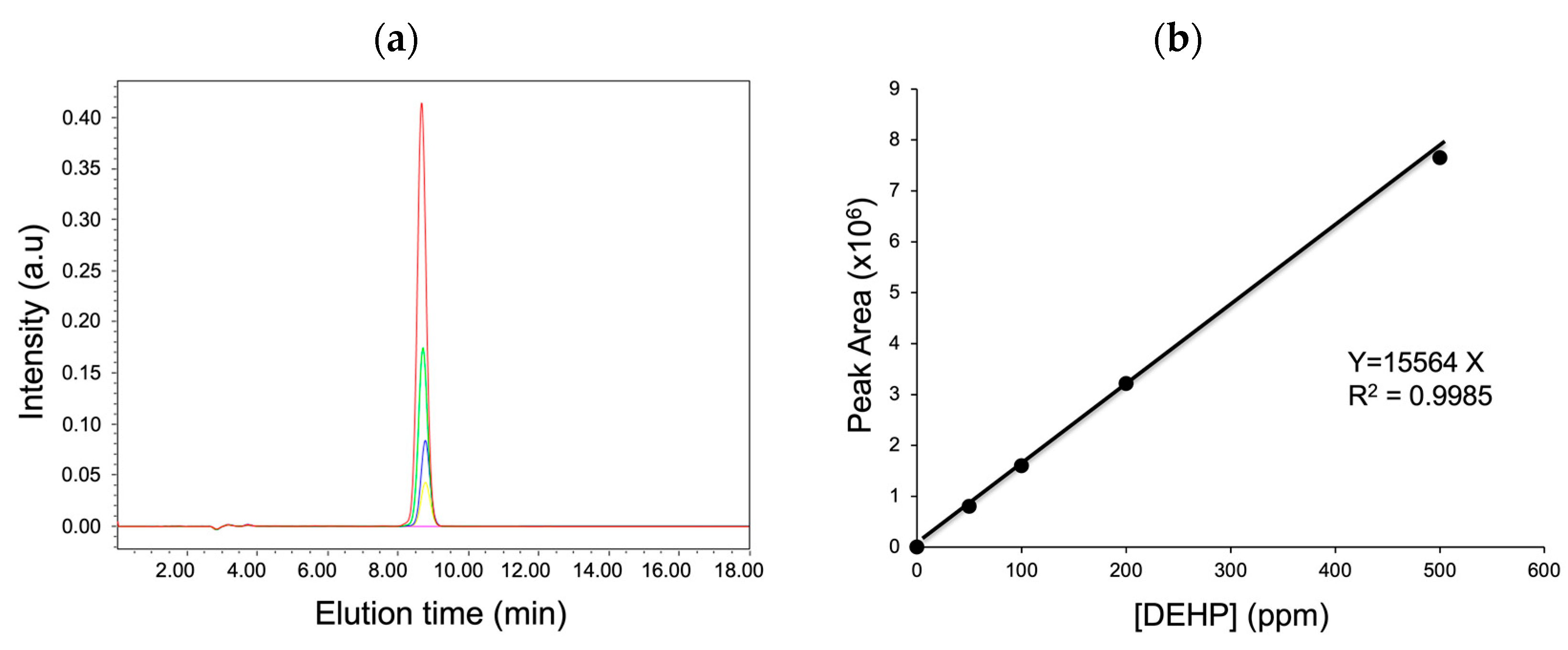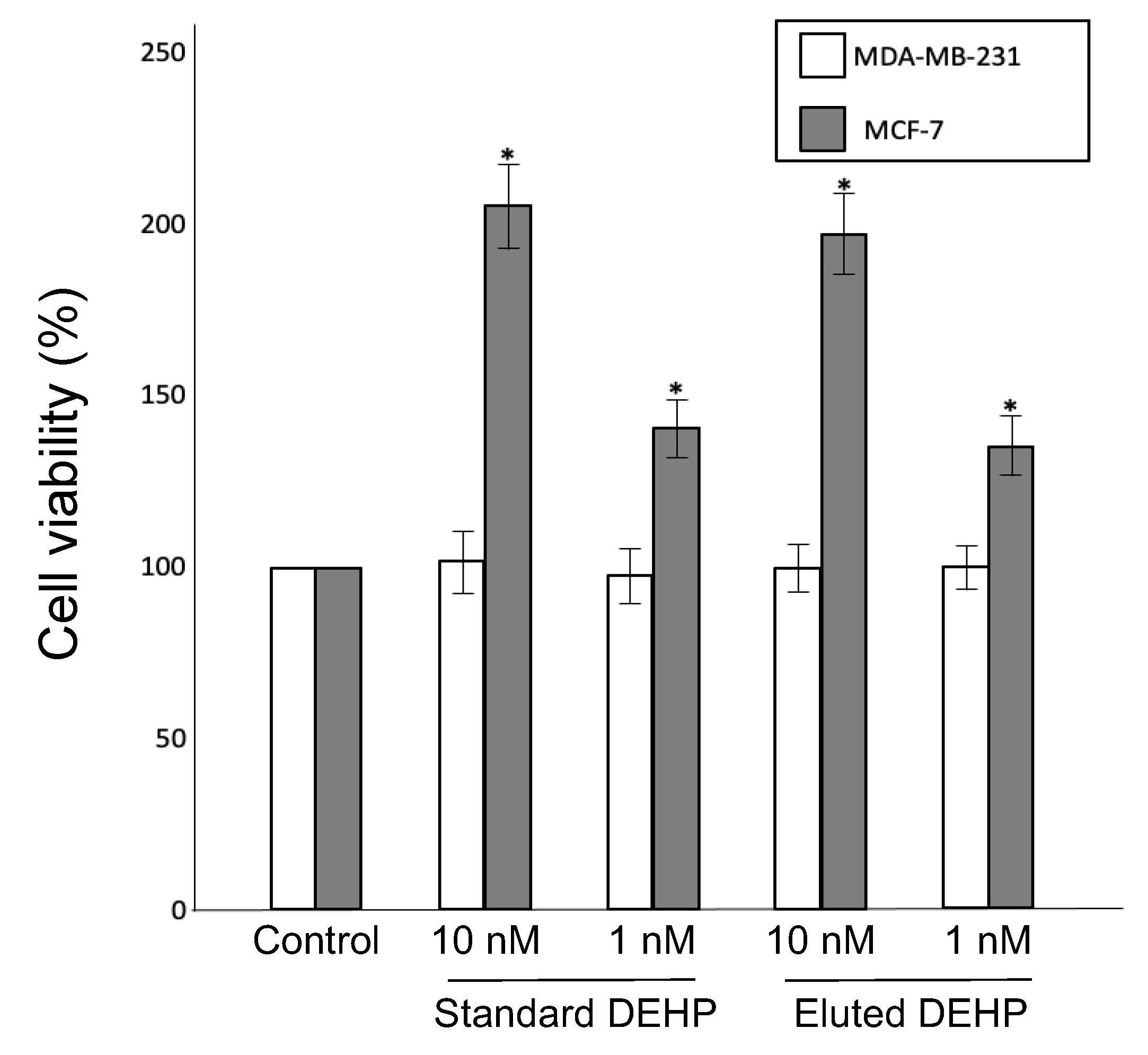Rapid Assessment of Di(2-ethylhexyl) Phthalate Migration from Consumer PVC Products
Abstract
:1. Introduction
2. Materials and Methods
2.1. Reagents and Materials
2.2. Preparation of Standard PVC Film
2.3. Migration of DEHP from PVC Films into Liquids
2.4. High-Performance Liquid Chromatography (HPLC)
2.5. Calibration Curve of DEHP for HPLC
2.6. Cell Culture and Cytotoxicity Evaluation
2.7. Statistical Analysis
3. Results and Discussion
4. Conclusions
Author Contributions
Funding
Informed Consent Statement
Data Availability Statement
Conflicts of Interest
References
- Plastics Europe. Plastics the Facts, an Analysis of European Plastics Production, Demand and Waste Data; Plastics Europe: Brussels, Belgium, 2021. [Google Scholar]
- Lewandowski, K.; Skórczewska, K. A brief review of poly(vinyl chloride) (PVC) recycling. Polymers 2022, 14, 3035. [Google Scholar] [CrossRef] [PubMed]
- Kumar, S. Recent Developments of Biobased Plasticizers and Their Effect on Mechanical and Thermal Properties of poly(vinyl chloride): A review. Ind. Eng. Chem. Res. 2019, 58, 11659–11672. [Google Scholar] [CrossRef]
- Wang, W.; Leung, A.O.W.; Chu, L.H.; Wong, M.H. Phthalates contamination in China: Status, trends and human exposure-with an emphasis on oral intake. Environ. Pollut. 2018, 238, 771–782. [Google Scholar] [CrossRef] [PubMed]
- Wang, Y.; Qian, H. Phthalates and their impacts on human health. Healthcare 2021, 9, 603. [Google Scholar] [CrossRef] [PubMed]
- McPartland, J.M.; Guy, G.W.; Di Marzo, V. Care and feeding of the endocannabinoid system: A systematic review of potential clinical interventions that upregulate the endocannabinoid system. PLoS ONE 2014, 9, e89566. [Google Scholar] [CrossRef] [PubMed]
- Desvergne, B.; Feige, J.N.; Casals-Casas, C. PPAR-mediated activity of phthalates: A link to the obesity epidemic? Mol. Cell. Endocrinol. 2009, 304, 43–48. [Google Scholar] [CrossRef] [PubMed]
- Arrigo, F.; Impellitteri, F.; Piccione, G.; Faggio, C. Phthalates and their effects on human health: Focus on erythrocytes and the reproductive system. Comp. Biochem. Physiol. C Toxicol. Pharmacol. 2023, 270, 109645. [Google Scholar] [CrossRef] [PubMed]
- Chou, C.K.; Huang, H.W.; Yang, C.F.; Dahms, H.U.; Liang, S.S.; Wang, T.N.; Kuo, P.L.; Hsi, E.; Tsai, E.M.; Chiu, C.C. Reduced camptothecin sensitivity of estrogen receptor-positive human breast cancer cells following exposure to di(2-ethylhexyl)phthalate (DEHP) is associated with DNA methylation changes. Environ. Toxicol. 2019, 34, 401–414. [Google Scholar] [CrossRef]
- Schettler, T. Human exposure to phthalates via consumer products. Int. J. Androl. 2006, 29, 134–139. [Google Scholar] [CrossRef]
- Just, A.C.; Adibi, J.J.; Rundle, A.G.; Calafat, A.M.; Camann, D.E.; Hauser, R.; Silva, M.J.; Whyatt, R.M. Urinary and air phthalate concentrations and self-reported use of personal care products among minority pregnant women in New York City. J. Expo. Sci. Environ. Epidemiol. 2010, 20, 625–633. [Google Scholar] [CrossRef]
- Lovekamp-Swan, T.; Davis, B.J. Mechanisms of phthalate ester toxicity in the female reproductive system. Environ. Health Perspect. 2003, 111, 139–145. [Google Scholar] [CrossRef] [PubMed]
- Rivera-Utrilla, J.; Ocampo-Pérez, R.; Méndez-Díaz, J.D.; Sánchez-Polo, M. Environmental impact of phthalic acid esters and their removal from water and sediments by different technologies—A review. J. Environ. Manag. 2012, 109, 164–178. [Google Scholar]
- Matsumoto, M.; Hirata-Koizumi, M.; Ema, M. Potential adverse effects of phthalic acid esters on human health: A review of recent studies on reproduction. Regul. Toxicol. Pharmacol. 2008, 50, 37–49. [Google Scholar] [CrossRef] [PubMed]
- Eales, J.; Bethel, A.; Galloway, T.; Hopkinson, P.; Morrissey, K.; Short, R.E.; Garside, R. Human health impacts of exposure to phthalate plasticizers: An overview of reviews. Environ. Int. 2022, 158, 106903. [Google Scholar] [CrossRef] [PubMed]
- Earla, A.; Li, L.B.; Costanzo, P.; Braslau, R. Phthalate plasticizers covalently linked to PVC copper-free or copper catalyzed azide-alkyne cycloadditions. Polymer 2017, 109, 1–12. [Google Scholar] [CrossRef]
- Andrade, A.J.M.; Grande, S.W.; Talsness, C.E.; Grote, K.; Chahoud, I. A dose–response study following in utero and lactational exposure to di-(2-ethylhexyl)-phthalate (DEHP): Non-monotonic dose–response and low dose effects on rat brain aromatase activity. Toxicology 2006, 227, 185–192. [Google Scholar] [CrossRef] [PubMed]
- Food and Drug Administration. Guidance for Industry: Limiting the Use of Certain Phthalates as Excipients in CDER-Regulated Products; Guidance Document, 2012; Food and Drug Administration: Silver Spring, MD, USA, 2012; P.1-8. FDA–2012-D–1135. [Google Scholar]
- Silano, V.; Baviera, J.M.B.; Bolognesi, C.; Chesson, A.; Cocconcelli, P.S.; Crebelli, R.; Gott, D.M.; Grob, K.; Lampi, E.; Mortensen, A. Update of the risk assessment of di-butylphthalate (DBP), butyl-benzyl-phthalate (BBP), bis(2-ethylhexyl)phthalate (DEHP), di-isononylphthalate (DINP) and di-isodecylphthalate (DIDP) for use in food contact materials. EFSA J. 2019, 17, 5838. [Google Scholar] [CrossRef]
- Testai, E.; Hartemann, P.; Rastogi, S.C.; Bernauer, U.; Piersma, A.; De Jong, W.; Gulliksson, H.; Sharpe, R.; Schubert, D.; Rodríguez-Farre, E.; et al. The safety of medical devices containing DEHP plasticized PVC or other plasticizers on neonates and other groups possibly at risk (2015 update). Regul. Toxicol. Pharmacol. 2016, 76, 209–210. [Google Scholar] [CrossRef]
- Eriksen, M.; Lebreton, L.C.M.; Carson, H.S.; Thiel, M.; Moore, C.J.; Borerro, J.C.; Galgani, F.; Ryan, P.G.; Reisser, J. Plastic pollution in the World’s oceans: More than 5 trillion plastic pieces weighing over 250,000 tons afloat at sea. PLoS ONE 2014, 9, e111913. [Google Scholar] [CrossRef]
- Barboza, L.G.A.; Gimenez, B.C.G. Microplastics in the marine environment: Current trends and future perspectives. Mar. Pollut. Bull. 2015, 97, 5–12. [Google Scholar] [CrossRef]
- Fries, E.; Dekiff, J.H.; Willmeyer, J.; Nuelle, M.T.; Ebert, M.; Remy, D. Identification of polymer types and additives in marine microplastic particles using pyrolysis-GC/MS and scanning electron microscopy. Environ. Sci. Process. Impacts 2013, 15, 1949–1956. [Google Scholar] [CrossRef] [PubMed]
- Rastogi, S.C. Gas chromatographic analysis of phthalate esters in plastic toys. Chromatographia 1998, 47, 724–726. [Google Scholar] [CrossRef]
- Green, R.; Hauser, R.; Calafat, A.M.; Weuve, J.; Schettler, T.; Ringer, S.; Huttner, K.; Hu, H. Use of di(2-ethylhexyl) phthalate-containing medical products and urinary levels of mono(2-ethylhexyl) phthalate in neonatal intensive care unit infants. Environ. Health Perspect. 2005, 113, 1222–1225. [Google Scholar] [CrossRef] [PubMed]
- Okubo, T.; Suzuki, T.; Yokoyama, Y.; Kano, K.; Kano, I. Estimation of estrogenic and anti-estrogenic activities of some phthalate diesters and monoesters by MCF-7 cell proliferation assay. Biol. Pharm. Bull. 2003, 26, 1219–1224. [Google Scholar] [CrossRef]
- Czogała, J.; Pankalla, E.; Turczyn, R. Recent attempts in the design of efficient PVC plasticizers with reduced migration. Materials 2021, 14, 844. [Google Scholar] [CrossRef]
- Bocqué, M.; Voirin, C.; Lapinte, V.; Caillol, S.; Robin, J.J. Petro-based and bio-based plasticizers: Chemical structures to plasticizing properties. J. Polym. Sci. Part A Polym. Chem. 2016, 54, 11–33. [Google Scholar] [CrossRef]


| Stimulant | Exposure Temperature (°C) | Exposure Time | Concentration (ppm) |
|---|---|---|---|
| distilled water | −20 | 4 weeks | ND a |
| 4 | 4 weeks | ND | |
| 25 | 4 weeks | ND | |
| 37 | 4 weeks | ND | |
| 121 b | 30 min | ND | |
| PBS | −20 | 4 weeks | ND |
| 4 | 4 weeks | ND | |
| 25 | 4 weeks | ND | |
| 37 | 4 weeks | ND | |
| 121 | 30 min | ND | |
| pH 1 | −20 | 4 weeks | ND |
| 4 | 4 weeks | ND | |
| 25 | 4 weeks | ND | |
| 37 | 4 weeks | ND | |
| 121 | 30 min | ND | |
| pH 13 | −20 | 4 weeks | ND |
| 4 | 4 weeks | ND | |
| 25 | 4 weeks | ND | |
| 37 | 4 weeks | ND | |
| 121 | 30 min | ND |
| Stimulant | Exposure Temperature (°C) | Exposure Time | Concentration (ppm) |
|---|---|---|---|
| 90% ethanol | 37 | 24 h | ND a |
| 37 | 72 h | 4.17 | |
| 37 | 1 week | 11.8 | |
| 121 b | 30 min | 11.3 | |
| M c | 15 s | 12.1 | |
| 100% ethanol | 37 | 24 h | ND |
| 37 | 72 h | 11.5 | |
| olive oil | 37 | 24 h | ND |
| 37 | 72 h | ND | |
| 37 | 1 week | ND | |
| 121 b | 30 min | 0.35 | |
| M c | 15 s | 0.37 | |
| acetone | 37 | 24 h | 69.0 |
| Stimulant | Condition | Distilled Water | pH 1 | pH 13 | Olive Oil | Ethanol (90%) | Acetone | |
|---|---|---|---|---|---|---|---|---|
| Product | ||||||||
| protective sheet | 37 °C, 24 h | ND b | ND | ND | 11261 | 1022 | 34,156 c | |
| M a, 15 s | ND | ND | 18.1 | 33,885 | 10,429 | 15,386 c | ||
| cover roll | 37 °C, 24 h | ND | ND | ND | 9294 | 8648 | 26,878 c | |
| M, 15 s | ND | ND | ND | 18,398 | 32,824 | 12,636 c | ||
| adhesive sheet | 37 °C, 24 h | ND | ND | ND | ND | ND | 4.3 | |
| M, 15 s | ND | ND | ND | 4.8 | 9.7 | 10.3 | ||
| hand warmer | 37 °C, 24 h | ND | ND | ND | 1239 | 927 | 3028 c | |
| M, 15 s | ND | ND | ND | 1528 | 1402 | 8735 c | ||
Disclaimer/Publisher’s Note: The statements, opinions and data contained in all publications are solely those of the individual author(s) and contributor(s) and not of MDPI and/or the editor(s). MDPI and/or the editor(s) disclaim responsibility for any injury to people or property resulting from any ideas, methods, instructions or products referred to in the content. |
© 2023 by the authors. Licensee MDPI, Basel, Switzerland. This article is an open access article distributed under the terms and conditions of the Creative Commons Attribution (CC BY) license (https://creativecommons.org/licenses/by/4.0/).
Share and Cite
An, J.; Roh, H.-H.; Jeong, H.; Lee, K.-Y.; Rhim, T. Rapid Assessment of Di(2-ethylhexyl) Phthalate Migration from Consumer PVC Products. Toxics 2024, 12, 7. https://doi.org/10.3390/toxics12010007
An J, Roh H-H, Jeong H, Lee K-Y, Rhim T. Rapid Assessment of Di(2-ethylhexyl) Phthalate Migration from Consumer PVC Products. Toxics. 2024; 12(1):7. https://doi.org/10.3390/toxics12010007
Chicago/Turabian StyleAn, Jiwon, Hyun-Ho Roh, Haeyoon Jeong, Kuen-Yong Lee, and Taiyoun Rhim. 2024. "Rapid Assessment of Di(2-ethylhexyl) Phthalate Migration from Consumer PVC Products" Toxics 12, no. 1: 7. https://doi.org/10.3390/toxics12010007
APA StyleAn, J., Roh, H.-H., Jeong, H., Lee, K.-Y., & Rhim, T. (2024). Rapid Assessment of Di(2-ethylhexyl) Phthalate Migration from Consumer PVC Products. Toxics, 12(1), 7. https://doi.org/10.3390/toxics12010007







